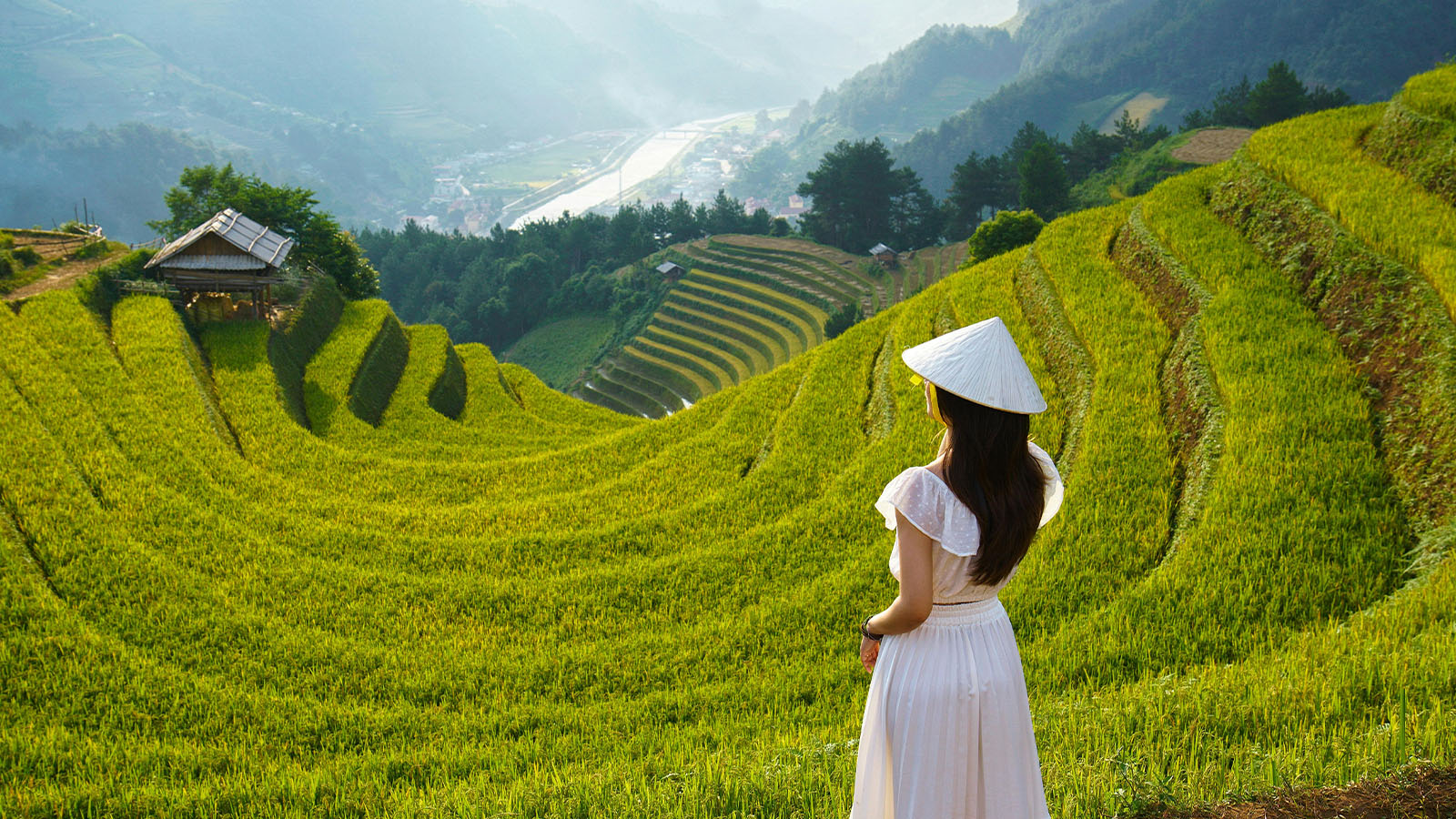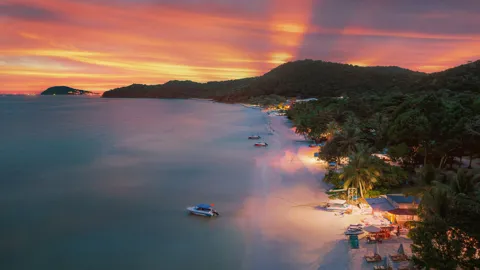Explore Northern Vietnam: 15 Must-See Destinations
Northern Vietnam is a captivating region where culture, history, and breathtaking natural beauty intertwine. Unlike the bustling metropolises of the south or the tranquil beaches of the central coast, the north enchants travelers with its dramatic landscapes, ancient traditions, and diverse ethnic communities. This region is also the cradle of Vietnamese civilization, home to the thousand-year-old capital of Hanoi and charming rural villages that preserve the essence of Vietnam's rich heritage.
In this article, we’ll guide you through the Top 15 destinations in Northern Vietnam to discover absolutely, sharing insights into what makes each place unique, what to do there, and when to visit. Get ready to embark on a journey that will leave you spellbound by Vietnam’s northern wonders.
#1 Mountains and Terraced Rice Fields in Sapa
Sapa is a mountain town in Lao Cai Province, surrounded by towering peaks and iconic terraced rice fields.
When you’re in Sapa, trekking is an absolute must. The trails take you through enchanting villages like Cat Cat, Ta Van, and Lao Chai, where you can meet ethnic minorities such as the Hmong and Dao people. The hikes range from easy walks to challenging climbs, so there’s something for everyone. Along the way, you’ll see locals in traditional clothes, water buffalo grazing, and, of course, the famous terraced fields that change colors with the seasons.
For a different perspective, you should ride the Muong Hoa funicular. It’s a short but scenic journey that gives you sweeping views of the valley below. The funicular connects Sapa town to the cable car station for Fansipan Mountain, the highest peak in Vietnam. The cable car ride itself is spectacular. It glides over lush forests and deep valleys, making the journey to Fansipan as memorable as the destination. Once you’re at the top, you can climb the final few hundred steps to the summit and marvel at the panoramic view that stretches into China on a clear day.
The best time to visit Sapa depends on what you want to see. For lush green rice fields, visit between May and August. If you prefer golden fields ready for harvest, September to November is ideal. Winter, from December to February, offers chilly weather and sometimes even snow, which is rare in Vietnam.
The Muong Hoa funicular costs about 200,000 VND for a round trip, and the Fansipan cable car ride is 800,000 VND for adults.
#2 Hanoi
Hanoi, the capital of Vietnam, is a city where the old meets the new. It enchants you with its Hoan Kiem Lake and the Old Quarter—the heart and soul of the city. The Old Quarter is a chaotic maze of narrow streets named after traditional trades where you can savor authentic pho and banh mi or shop for souvenirs. Don’t miss the Temple of Literature, Vietnam’s first university, or the Ho Chi Minh Mausoleum, where you can learn about the country’s revered leader.
If you want to venture off the beaten path, Hanoi’s surroundings offer hidden gems. Duong Lam Ancient Village, about 50 kilometers away, with its century-old houses made of laterite, tranquil courtyards, and pagodas, is perfect for a quiet escape. Craft villages like Bat Trang (famous for ceramics) and Van Phuc (known for silk weaving) let you witness traditional artistry and even try it yourself.
Hanoi is delightful year-round, but autumn (September to November) is particularly charming with cool weather and golden leaves. Entrance fees to landmarks like the Temple of Literature or Ho Chi Minh Mausoleum are affordable, ranging from 30,000 to 50,000 VND ($1–2 USD).
#3 The Famous Ha Long Bay
Ha Long Bay is a UNESCO World Heritage Site and one of the most iconic destinations in Vietnam, with over 1,600 limestone islands and emerald-green waters. A cruise is the best way to experience Ha Long Bay. You can choose from day trips or overnight cruises, which include stops at caves like Sung Sot (Surprising Cave) or kayaking through hidden lagoons. There are also many onboard activities to discover, such as joining cooking classes, nighttime squid fishing, or morning Tai Chi on the sundeck.
The best time to visit is from October to April, when the weather is cooler and less humid. Cruise prices vary, with day tours starting around $30 USD and luxury overnight cruises costing $150–300 USD.
#4 Tam Coc, “Ha Long Bay on land”
Tam Coc, located in Ninh Binh Province, is often called “Ha Long Bay on land” for its limestone karsts rising above rice paddies. What sets Tam Coc apart is its tranquil countryside vibe. You’ll experience its beauty best by taking a boat ride along the Ngo Dong River. The boat trip passes through three natural caves, and the scenery changes with the seasons, from lush green to golden hues.
Cycling around Tam Coc is another great way to explore. You can visit nearby attractions like Bich Dong Pagoda, which is partly built into a mountain, or Hang Mua, a viewpoint that offers panoramic views of the entire area.
The best time to visit Tam Coc is from May to June, when the rice fields are at their most vibrant. Boat rides cost around 250,000 VND ($6 USD) per person.
#5 Mai Chau
Mai Chau is a serene valley surrounded by mountains and dotted with stilt houses of the Thai ethnic group. It’s a quieter alternative to Sapa, offering a mix of relaxation and cultural discovery. The town of Mai Chau is small, but the surrounding villages like Lac and Pom Coong are where you’ll truly connect with the local way of life.
Trekking and biking are the best ways to explore Mai Chau. The trails lead you through rice fields, bamboo forests, and small villages. You can also enjoy a traditional Thai dance performance or a home-cooked meal with a local family. The stilt houses, many of which now serve as homestays, provide a comfortable and authentic experience.
Mai Chau is ideal to visit in October and November when the weather is cool and the rice fields turn golden. Entrance to villages is free, but activities like guided treks or performances may cost around 200,000–300,000 VND ($8–12 USD).
#6 Pu Luong
Pu Luong Nature Reserve, tucked away in Thanh Hoa Province, offers a serene escape for nature lovers. This lesser-known gem is a mix of terraced rice fields, lush forests, and traditional villages, perfect for those seeking tranquility and authenticity. Unlike the more crowded Sapa, Pu Luong feels more untouched and peaceful.
Trekking is the highlight here. The trails lead you through breathtaking rice terraces, bamboo forests, and local villages like Don and Kho Muong. The village of Kho Muong, in particular, has a fascinating limestone cave worth exploring. If you’re looking for a leisurely activity, cycling around the valley or simply enjoying the view from an eco-lodge is equally rewarding.
The best time to visit Pu Luong is from May to June or September to October, when the rice terraces are at their most vibrant.
#7 Ha Giang
Ha Giang is Vietnam’s northernmost province and home to some of the country’s most dramatic landscapes. Known for the Ha Giang Loop, a motorbike route through towering mountains, deep valleys, and winding roads, it’s an adventurer’s dream. The rugged beauty here feels like a world apart from the bustling cities.
You can ride or hire a guide to explore the loop, which passes through iconic spots like Dong Van Karst Plateau, Lung Cu Flag Tower (Vietnam’s northernmost point), and Ma Pi Leng Pass, often called the most beautiful pass in Vietnam. Along the way, you’ll find local markets, where ethnic groups like the Hmong and Tay sell handmade goods and fresh produce.
The best time to visit Ha Giang is during the buckwheat flower season in October and November or from April to May when the landscape is lush and green.
#8 Hoang Su Phi
Hoang Su Phi, also in Ha Giang Province, is famous for its terraced rice fields that cascade down mountainsides in intricate patterns. It’s one of the most remote and stunning regions in Vietnam, ideal for those who enjoy trekking and want to experience life in highland villages.
The rice terraces here are even more dramatic than in Sapa or Mu Cang Chai. Trekking trails take you to villages like Ban Phung and Ban Luoc, where you can meet ethnic groups like the Dao and Nung. The area is less touristy, so you’ll feel a genuine connection with the locals.
The best time to visit Hoang Su Phi is from September to October during the harvest season when the rice fields turn golden.
#9 Bac Ha
Bac Ha is known for its vibrant Sunday Market, a hub for ethnic minorities from the surrounding mountains. Located in Lao Cai Province, Bac Ha is a great place to experience traditional culture and purchase unique handmade goods.
The Sunday Market is the highlight. You’ll see locals in colorful attire selling everything from livestock to intricate textiles. Nearby, the Hoang A Tuong Palace, built during the French colonial era, offers a glimpse into the region’s history. Trekking to the nearby Ban Pho Village, famous for its corn wine, is another activity worth trying.
Visit Bac Ha in spring (March to May) when the weather is mild, or in June for the plum season, as the region is known for its delicious plums. The Sunday Market is free to enter, but items like textiles and souvenirs vary in price.
#10 Mu Cang Chai
Mu Cang Chai in Yen Bai Province is a paradise for photography and nature enthusiasts. Its terraced rice fields, often called a “living art gallery,” are among the most beautiful in the world. The landscape here is breathtaking, especially during the harvest season.
Trekking is the best way to experience Mu Cang Chai. Trails lead you through villages like La Pan Tan, Che Cu Nha, and De Xu Phinh, where you can witness daily life and traditional farming methods. Paragliding is also an option for thrill-seekers during the annual festival in September, offering aerial views of the terraces.
The best time to visit Mu Cang Chai is from late September to early October during the golden harvest.
#11 Ba Be
Ba Be National Park in Bac Kan Province is home to Ba Be Lake, the largest freshwater lake in Vietnam. Surrounded by limestone mountains, lush forests, and serene villages, it’s an idyllic destination for nature enthusiasts. The park is also rich in biodiversity, making it a haven for bird watchers and wildlife lovers.
A boat ride on Ba Be Lake is the best way to enjoy its beauty. The journey takes you to Puong Cave, a limestone cavern carved by the Nang River, and Dau Dang Waterfall, where the river cascades into a series of picturesque pools. Trekking and cycling are other popular activities, especially around ethnic villages like Pac Ngoi, where you can stay in traditional stilt houses.
The best time to visit Ba Be is from October to April, when the weather is dry and pleasant. Entrance fees to the park cost around 70,000 VND ($3 USD), and boat rentals vary based on the route.
#12 Cao Bang
Cao Bang, located near the Chinese border, is a hidden gem known for its breathtaking landscapes and cultural diversity. The province is home to Ban Gioc Waterfall, one of the most stunning waterfalls in Southeast Asia. The falls straddle the border, creating a spectacular scene with water cascading down multiple tiers.
From Ban Gioc, you can visit Nguom Ngao Cave, a limestone cave filled with stalactites and stalagmites in fascinating shapes. Cao Bang is also rich in history; Pac Bo Cave, where Ho Chi Minh lived and worked upon his return to Vietnam, is a significant historical site.
The best time to visit Cao Bang is from September to October or March to May, when the weather is pleasant. Entrance to Ban Gioc Waterfall is 45,000 VND ($2 USD), and visiting Nguom Ngao Cave costs around 30,000 VND ($1 USD).
#13 Bai Tu Long
Bai Tu Long Bay, located northeast of Ha Long Bay, offers the same stunning limestone karsts but with fewer crowds. It’s a perfect destination for those seeking tranquility and unspoiled natural beauty.
Cruising through Bai Tu Long Bay lets you explore hidden caves, pristine beaches, and floating fishing villages like Vung Vieng. The bay also has its own version of Sung Sot Cave, known as Thien Canh Son Cave, where you can marvel at stunning formations. Kayaking and swimming are common activities, and many cruises include stops at Bai Tu Long National Park, which is a biodiversity hotspot.
The best time to visit Bai Tu Long Bay is from October to April when the weather is cooler. Cruise prices are similar to those in Ha Long Bay, starting at $100 USD for overnight options, and most include entrance fees to the attractions.
#14 Lan Ha Bay
Lan Ha Bay, located to the south of Ha Long Bay, is an emerging destination that boasts over 300 small islands and islets. It’s a quieter alternative to Ha Long Bay, with emerald waters and white-sand beaches.
A cruise is the best way to explore Lan Ha Bay. Most itineraries include kayaking through sea caves, swimming in secluded lagoons, and visiting floating villages like Cai Beo, one of Vietnam’s oldest fishing communities. Cat Dua Island, also known as Monkey Island, is a popular stop, offering a short hike with panoramic views.
The best time to visit Lan Ha Bay is from September to April when the weather is comfortable. Cruise prices range from $100 to $150 USD for overnight stays, including most activities and entrance fees.
#15 Cat Ba
Cat Ba Island is a mix of rugged mountains, beaches, and vibrant villages. It’s a favorite for travelers looking for a blend of adventure and relaxation.
The island is home to Cat Ba National Park, where you can hike through dense forests to Ngu Lam Peak for stunning views. If you’re more into water activities, you can kayak around the island, explore hidden caves, or simply relax on Cat Co beaches. The town of Cat Ba is lively, offering a variety of seafood restaurants and bars.
The best time to visit Cat Ba is from April to November, with the summer months ideal for beach lovers. Entrance to Cat Ba National Park costs around 80,000 VND ($3 USD), and other activities like boat tours or kayaking range from $10 to $30 USD.
Conclusion
Northern Vietnam is a region that promises unforgettable experiences for every traveler. Whether you’re marveling at the towering karsts of Lan Ha Bay, trekking through the terraced fields of Hoang Su Phi, or soaking in the serene beauty of Ba Be Lake, each destination offers a unique slice of Vietnam’s charm.
If this article has inspired you to explore the Top 15 destinations in Northern Vietnam to discover absolutely, why not turn your dream into reality? Book a tour with us and let our experienced team help you craft the perfect itinerary. From local insights to hassle-free travel arrangements, we’ll ensure your journey through Northern Vietnam is nothing short of extraordinary. Let’s start planning your adventure today!
Send us your comments about : Explore Northern Vietnam: 15 Must-See Destinations
Required fields *
You might also be interested
Travel ideas
Need some inspiration? Discover some of the best tours in Vietnam, which are highly appreciated by our clients. An excellent starting point to help you choose the right trip to Vietnam, Laos, Cambodia, Burma or Thailand, whether you are traveling alone, as a couple, as a family or with friends.
And because this trip is yours, feel free to customize it as you wish!
Vietnam Cambodia Itinerary 14 Days
Hanoi – Hoa Binh – Mai Chau – Ninh Binh – Halong bay – Hue - Danang – Hoian – Saigon – Ben Tre - Can Tho – Saigon - Siem Reap Angkor - Tonlé Sap - Siem Reap – Ta Prohm - Departure
Vietnam 14 Day Itinerary
Vietnam 14-day itinerary covers the country’s top highlights and quintessential experiences for an unforgettable journey.
Honeymoon Tour Pakcages In Vietnam 12 Days
Saigon Arrival - City Tour – Mekong Delta – Danang – Hoian - by flight - Da Nang – Hanoi - by flight – Halong - overnight on junk – Departure
Authentic Hoang Su Phi Trekking Tours
Hoang Su Phi trekking tours take you to stunning terraces, meet few tourists, connect with locals and enjoy authentic culture.
Best Nha Trang Beach Tour 4 Days
Saigon/Hanoi – Nha Trang relaxation – Saigon/Hanoi – Departure
Mekong Delta Bike Tour Itinerary 7 Days
Cycle through the Mekong Delta in 7 days, discovering floating markets, orchards, craft villages, and tranquil green islands.
Are you interested in this tour?



























Comment